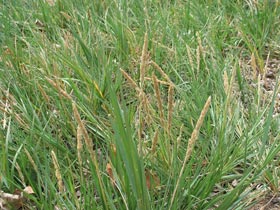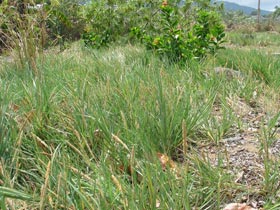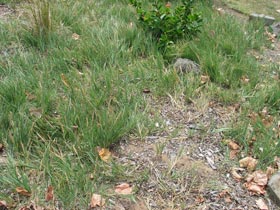Sporobolus virginicus
Genus
Sporobolus
Species
virginicus
Hawaiian Names with Diacritics
- Mahiki
- Māhikihiki
- Mānienie
- Mānienie maoli
- Mānienie māhikihiki
- Mānienie ʻakiʻaki
- ʻAki
- ʻAkiʻaki
Hawaiian Names
- Aki
- Akiaki
- Mahiki
- Mahikihiki
- Manienie
- Manienie akiaki
- Manienie mahikihiki
- Manienie maoli
Common Names
- Beach dropseed
- Saltgrass
- Sand couch
- Seashore dropseed
- Seashore rush grass
- Seashore rushgrass
Distribution Status
Indigenous
Endangered Species Status
No Status
Plant Form / Growth Habit
- Non-Woody, Clumping
- Non-Woody, Spreading
Mature Size, Height (in feet)
- Grass-like, Short, Less than 1
- Grass-like, Medium, 1 to 2.5
Mature Size, Width
ʻAkiʻaki size varies greatly because of the spreading nature via rhizomes, but its width may range anywhere from 2 to 10 feet or more.
Life Span
Long lived (Greater than 5 years)
Landscape Uses
- Accent
- Erosion Control
- Ground Cover
Additional Landscape Use Information
Outplant in a site that mimics the environment, allowing room for the grasses to grow and the seeds to regenerate themselves. Though not suitable as a turfgrass, it has been suggested that this native grass could be used for golf course roughs.
Source of Fragrance
- Leaves
Additional Fragrance Information
ʻAkiʻaki leaves have a pungent odor.
Plant Produces Flowers
Yes
Flower Type
Not Showy
Flower Colors
- Brownish
- Yellow
Additional Flower Color Information
ʻAkiʻaki is densely flowered with glossy grayish or yellowish brown spikelets.
Blooming Period
- Year Round
Plant texture
- Fine
- Medium
- Coarse
Additional Plant Texture Information
The hairy leaf blades range from 1 to over 5 inches long.
Leaf Colors
- Light Green
Additional Pest & Disease Information
This native grass is prone to ants, scale, mealy bugs, thrips and aphids.
Fertilizer
Low fertilizer requirements, as is the case with most native grasses. ʻAkiʻaki does not appear to be a heavy feeder and can grow in low nutrient soils with some organic matter. Foliar feedings in early morning with a water-soluble or an organic fertilizer (e.g. kelp or fish emulsion) at one-third to one-fourth the recommended strength every other month have proved to be beneficial. [David Eickhoff, Native Plants Hawaiʻi]
Additionally, this coastal indigenous grass seems to appreciate, and even thrive, with an occasional spritz of sea water. But apply only to areas dedicated for salt tolerant coastal plants, as salt can be difficult to leach from upland soils once in the soil. [David Eickhoff, Native Plants Hawaiʻi]
Pruning Information
No pruning is required. ʻAkiʻaki does not take mowing well, but can occasionally be trimmed with a string trimmer (weed whacker) at higher trimmings of at least five inches or higher. [David Eickhoff, Native Plants Hawaiʻi]
Water Requirements
- Dry
- Moist
Additional Water Information
ʻAkiʻaki grows naturally in dry conditions but seems to prefer moist conditions until it is established. Then, watering can be cut back as the plant will tolerate short periods of drought.
Soil must be well drained
Yes
Light Conditions
- Full sun
Spacing Information
Depending on how quickly the area needs to be covered, space ʻakiʻaki stolons or plugs about 4 to 10 inches apart. The plantings will grow together to form a sparse to dense patch. Growth rate is moderate.
Plants will also reseed themselves, hence the common name dropseed.
Tolerances
- Drought
- Brackish Water
- Wind
- Salt Spray
- Heat
Soils
- Sand
- Cinder
- Organic
- Coral
Limitations
Somewhat drought tolerant for short periods of time but does better with some moisture.
ʻAkiʻaki does not make a good turfgrass for lawns and will decline with high foot traffic.
Natural Range
- Niʻihau
- Kauaʻi
- Oʻahu
- Molokaʻi
- Lānaʻi
- Maui
- Kahoʻolawe
- Hawaiʻi
- Northwest Islands
Natural Zones (Elevation in feet, Rainfall in inches)
- Less than 150, 0 to 50 (Dry)
Habitat
- Terrestrial
Additional Habitat Information
ʻAkiʻaki occurs on coastal dunes and other coastal sites just above the high tide mark to about 50 ft. on all of the main islands and on Midway Atoll (Pihemanu) and Laysan (Kauō) in the Northwest Islands.
![]() Special Features and Information
Special Features and Information
General Information
ʻAkiʻaki (Sporobolus virginicus) belong to the Poaceae (Grass family). Of the seven or eight species now found in Hawaiʻi, only this species is indigenous.
Etymology
The genus name Sporobolus is derived from the Greek sporos, seed, and ballein, to throw, in reference to the fruit (the pericarp) which swells and bursts when soaked, thus pushing out or dropping the seed. Dropseed is a vernacular name for this grass.
The specific epithet virginicus has reference to "from the Virgin Islands, Virginian." [2]
Early Hawaiian Use
The leaves, culms and roots were used medicinally. [3] The plant was mixed with other ingredients and used to treat ʻea (thrush) and pāʻaoʻao (childhood disease, with physical weakening). [1]
Modern Use
ʻAkiʻaki is currently used for erosion control on sand dunes and other unstable coastal areas. [3]
Additional References
[1] "Native Hawaiian Medicine--Volume III" by The Rev. Kaluna M. Kaʻaiakamanu, page 74.
[2] "The Names of Plants" by David Gledhill, page 402.
[3] "Hawaiʻi Wetland Field Guide" by Terrell A. Erickson and Christopher F. Puttock, page 269.
PHOTOS FOR THIS SPECIES CAN BE SEEN AT THE LINK (Copy & Paste to your browser):
https://www.flickr.com/search/?user_id=50823119%40N08&sort=date-taken-desc&view_all=1&text=Sporobolus%20virginicus
Plant Gallery
Back to Plant List
Other Nursery Profiles for Sporobolus virginicus



